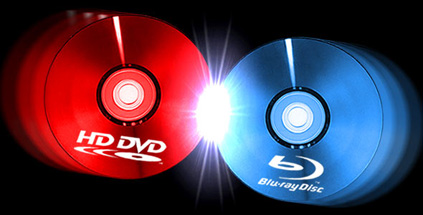|
|
Intermittent Issues:
|

|
At the time of the blue-violet laser diode’s creation, Sony actually chaired the DVD Forum. The diode’s creation spurred a dilemma that would eventually form a rift: whether to use the diode in a production capacity, now that it was shown to be feasible. There were two main issues that needed to be resolved: one, using the blue-violet laser diode was inherently more expensive than attempting HD content using red-laser diodes. The other issue involved form factor.New at BOP: Share & Save
![]() Tweet
Tweet
![]() Print this column
Print this column
Due to the sensitive nature of the blue-violet laser light, the protective layer that was utilized on CDs, DVDs, and other optical discs up to that point was determined to be too thick. Blu-ray Discs were going to need a protective layer thinner than anything provided, which introduced its own set of problems. Namely: damage. A thinner protective layer meant that, as easy as it was to scratch a CD or DVD beyond playability, a Blu-ray Disc would be even easier to scratch. Considering the greater density of the data, a simple scratch could easily be catastrophic to the disc’s integrity.
Sony’s solution to this was a sturdy plastic disc caddy, one that operated in a similar fashion to the plastic shell of a floppy disk: a small portion of the caddy would be open, exposing the Blu-ray Disc to the laser, while the rest of the disc would be sheltered behind a plastic wall thick enough to withstand mishandling, drops, being dragged behind a moving bus, anything.
|
Advertisement |
Personal note: A production company that I briefly worked for back in 2006 used Sony HD camcorders, and the cameras utilized the caddy-based Sony Professional Disc, which had a very similar form factor to these early Blu-rays. I’m barely exaggerating as far as the dragged-behind-a-bus thing; those suckers could take a lot of abuse. Not that I know from personal experience, or anything. Sometimes you don’t have to drop something off of the roof of a building to see if it survives in order to know that it would.
The problem with the caddy was twofold: it was expensive to manufacture (those Professional Discs I talked about just now cost the company roughly $25 per disc, and that was at wholesale prices), and it wrecked the form factor. The Blu-rays were housed like floppy disks, and they looked and felt about that cumbersome.
This was Sony’s entry into the optical HD world. Blu-ray possessed a staggering amount of promise - a dual-layer disc could theoretically hold six times the amount of data as a dual-layer DVD - and a couple of major obstacles to mass-market implementation.
[ Email this column ]

|
|
|

|
Wednesday, April 24, 2024
© 2024 Box Office Prophets, a division of One Of Us, Inc.

